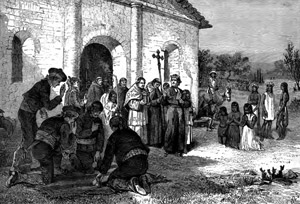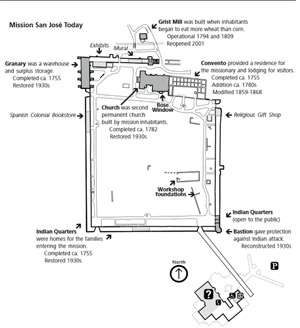
By William Ludwell Sheppard (1833-1912). Courtesy of Wikimedia Commons.
This is an essay from the Spanish Missions of the Southwest Travel Itinerary
Known as the Custodio y Conversión de San Pablo, the newly appointed prelate of the New Mexico mission field Fray Alonso de Benavides arrived with the supply caravan of 1626. Accompanied by twelve Franciscans, they joined fourteen missionaries, already residing in New Mexico. Benavides' arrival signaled a new beginning for the New Mexican missions. The tireless friar, who held the titles of Father Custodian and Commissary of the Holy Office of the Inquisition, toiled in the expanded mission field and promoted it with his prolific quill. Written for the Pope and Spanish king, his Memorial of 1630, and a revised version in 1634 were published in five languages before the end of seventeenth century. An offshoot of the colonial Mexican Church, the New Mexico missions were not unlike other mission provinces in the Americas. In his Memorial, Benavides offered a composite, albeit romanticized, view of "the pious tasks of the friars in these conversions."

Photo by Ansel Adams. Courtesy of the National Archives
Benavides' universal description of a day in the life of a missionary resonated in the daily lives of missionaries in remote lands. He wrote:
Since the land is very remote and isolated and the difficulties of the long journeys require more than a year of travel, the friars, although there are many who wish to dedicate themselves to those conversions, find themselves unable to do so because of their poverty. Hence, only those who go there are sent by the Catholic King, at his own expense, for the cost is too excessive that only his royal zeal can afford it. This is the reason that there are few friars over there and that most of the convents have only one religious each, and he ministers to four, six, or more neighboring pueblos, in the midst of which he stands as a lighted torch to guide them in spiritual as well as temporal affairs. More than twenty Indians, devoted to the service of the church, live with him in a convent. They take turns in relieving one another as porters, sextons, cooks, bell ringers, gardeners, refectioners, and in other tasks. They perform their duties with as much circumspection and care as if they were friars. At eventide, they say their prayers together, with much devotion, in front of some image.
In every pueblo where a friar resides, he has schools for the teaching of praying, singing, playing musical instruments and other interesting things. Promptly at dawn, one of the Indian singers, whose turn it is that week, goes to ring the bell for the Prime, at the sound of which those who go to school assemble and sweep the rooms thoroughly. The singers chant the Prime in the choir. The friar must be present at all of this and takes note of those who have failed to perform this duty, in order to reprimand them later. When everything is neat and clean, they again ring the bell and each one goes to learn his particular specialty;the friar oversees it all, in order that these students may be mindful of what they are doing. At this time those who plan to get married come and notify him, so that he may prepare and instruct them according to our holy council;if there are any, either sick or healthy persons, who wish to confess in order to receive communion at mass, or who wish anything else, they come to tell him. After they have been occupied in this manner for an hour and a half, the bell is rung for mass. All go into the church, and the friar says mass and administers the sacraments. Mass over, they gather in different groups, examine the lists, and take note of those who are absent in order to reprimand them later. After taking the roll, all kneel down by the church door and sing the Salve in their own tongue. This concluded, the friar says: "Praised be the most Holy Sacrament," and dismisses them, warning them first of the circumstances with which they should go about their daily business.

NPS photo.
At mealtime, the poor people in the pueblo who are not ill come to the porter's lodge, where the cooks of the convent have sufficient food ready, which is served to them by the friars;food for the sick is sent to their homes. After mealtime, it always happens that the friar has to go to some neighboring pueblo to hear a confession or to see if they are careless in the boys' school, where they learn to pray and assist at mass for this is the responsibility of the sextons and it is their duty always to have a dozen boys for the service of the sacristy and to teach them how to help at mass and how to pray.
In the evening, they toll the bell for vespers, which are chanted by the singers who are on duty for the week, and, according to the importance of the feast, they celebrate it with organ chants as they do for mass. Again the friar supervises and looks after everything, the same as in the morning.
On feast days, he says mass in the pueblo very early, and administers the sacraments and preaches. Then he goes to say a second mass in another pueblo, whose turn it is, where he observes the same procedure, and then he returns to his convent. These two masses are attended by the people of the tribe, according to their proximity to the pueblo where they are celebrated.

From the Mission San Jose Visitor’s brochure. Courtesy of the National Park Service.
One of the weekdays which is not so busy is devoted to baptism and all those who are to be baptized come to the church on that day, unless some urgent matter should intervene;in that case, it is performed at any time. With great care, their names are inscribed in a book;in another, those who are married;and in another, the dead.
One of the greatest tasks of the friars is to adjust the disputes of the Indians among themselves, for since they look upon him as a father, they come to him with all their troubles, and he has to take pains to harmonize them. If it is a question of land and property, he must go with them and mark their boundaries, and thus pacify them.
For the support of all the poor of the pueblo, the friar makes them sow some grain and raise some cattle, because if he left it to their discretion, they would not do anything. Therefore, the friar requires them to do so and trains them so well that with the meat he feeds all the poor and pays the various workmen who come to build the churches. With the wool he clothes all the poor, and the friar himself also gets his clothing and food from this source. All the wheels of this clock must be kept in good order by the friar, without neglecting any detail, otherwise all would be totally lost.
The most important thing is the good example set by the friars. This, aside from the obligations of their vows, is forced upon them because they live in a province where they concern themselves with nothing but God. Death stares them in the face everyday! Today one of their companions is martyred, tomorrow, another;their hope is that such a good fortune may befall them while living a perfect life.
Tags
- san antonio missions national historical park
- discover our shared heritage travel itinerary program
- heritage travel
- spanish missions of the southwest travel itinerary
- spanish missions
- colonial spanish missions
- native american
- indian
- jesuits
- missionaries
- spanish
- spain
- catholic
- church
- monestary
- alamo
- national historic trail
- san antonio missions
- hispanic
- latino
- early settlement
- american indian tribes
- national register of historic places
Last updated: April 15, 2016
